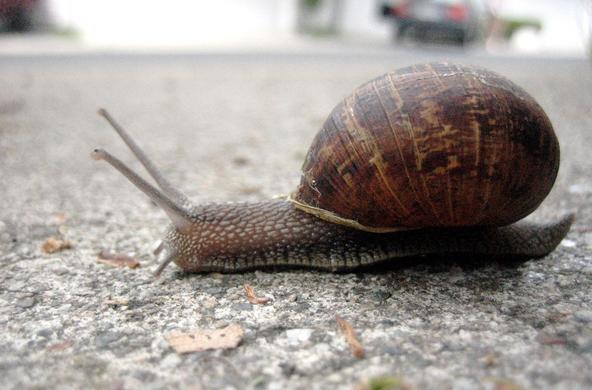When cheap consumer goods arrive on American shores, they sometimes bring invasive parasites that go on to decimate forests and urban trees. A new study, out Tuesday in the journal Ecological Applications, synthesizes the information available on the true costs of these species and lays out the best available policy responses.
Tree-killing insects have been hitching rides across the oceans for years, but the rate of imports to the U.S. has risen dramatically over the past three decades and now totals 25 million shipping containers a year. As trade expands, so too do the opportunities for parasites to cross over in wooden shipping material or nestled into imported plants. (Their increase is tracked in the chart below.) A hundred years ago, it was chestnut blight and Dutch Elm disease; today, leading pests include emerald ash borer, the Asian longhorned beetle, and hemlock woolly adelgid. When these insects arrive and find trees that lack evolved defenses to them, they can wipe out entire species within a few decades. A startling 63 percent of U.S. forests are now at risk of losing trees to invasive species.
When a whole species dies out in a forest, it alters the population of trees, the chemistry of the forest floor, and the surrounding constellations of flora and fauna. The costs are particularly pronounced in cities, where trees counter the urban heat island effect, capture stormwater runoff, purify the air, promote the health and wellbeing of people, and increase property value. Urban green space has even been linked to decreases in crime rates. The dead trees themselves impose a cost, too, because they have to be removed so they don't pose a threat to people and property.
"By allowing [pests] to get through and then dealing with them afterward, we're increasing our costs and shifting the costs to the local homeowners and local municipalities as opposed to putting it back on the importers, where it belongs," says the report's lead author Gary Lovett, a forest ecologist at the Cary Institute of Ecosystem Studies.
The report cites a recent analysis of the annual expenses imposed by invasive forest insects (illustrated in the chart below): $2 billion for local governments, $1.5 billion in property value declines, $1 billion for homeowners, $216 million for the federal government, and $150 million for the timber industry.
The people bearing those costs are not the ones directly causing the problem, and that burden will only increase as more foreign species enter the American landscape, so the only real hope is stopping them before they get in. Here's how Lovett recommends doing that:
Stop using wood to ship things
Since 90 percent of the wood-boring invasives arrived via wooden shipping materials, the best way to stop them is to cease packing goods in wood. Even the current protocol of treating wood crates with chemicals or heat fails to stop more than half of the pests. That's because the treatments don't necessarily kill all the bugs, Lovett says. Alternatively, insects can infest the crates after they've been treated. Then again, it's also possible for shippers to cheat and stamp the crates as treated even if they haven't been.
Plenty of alternatives already exist, Lovett says, like manufactured wood, recycled plastics, or paper-based products. IKEA uses paper shipping materials, which are lighter and more easily conform to the shape of the objects, which allows them to pack more goods in the same amount of space. That helps them save money.
This industry transition would impose costs up front, which shippers would likely pass on to consumers in the form of higher prices. "To me, that's where it should be," Lovett says. "We should be paying the true costs of importation of these goods, not some discounted cost that allows the damages to be spread out across the larger population."
In the end, paying for more prevention up front is the better deal, at least at the society-wide level. For instance, the current, admittedly imperfect, extermination policies will cost $5 billion through 2050, but they're expected to yield cumulative net benefits of $11 billion by catching some of the stowaways. To catch them all, the U.S. will need to make additional measures a requirement for access to American markets.
Stop importing live trees
Most invasive tree-killers enter the country on live plants which are shipped to the U.S. for sale. The most straightforward prevention measure, the study says, would be to ban the imports of live trees, or at least those closely related to North American trees. This probably won't be popular with the gardening industry—it would cut the of supply of exotic plants, not to mention the potential for cheaply raising plants overseas to sell at profit in the U.S. Once again, this boils down to a political question of who should bear the costs for this particular type of commerce.
Failing that, the government could work with the industry to adopt voluntary standards for plant importation that minimize the risk of introducing pests.
Anticipate the next big pest
The emerald ash borer took North America by surprise because nobody knew to look out for it; it had never been seen there before, and it wasn't an issue in Asia because the trees there developed a resistance. This points to an fundamental difficulty in the fight against invasives: it's hard to know they'll be a problem until they become one.
The study points to a promising workaround for this: the International Sentinel Plant Network, which plants American trees overseas to see if they get clobbered by previously unknown pests. This "canary in the coal mine" approach makes a lot of sense, but it needs to be active in a broader geographical range to be effective at flagging new threats.
Adequately fund inspectors
Funding for cargo inspections has not kept pace with the increase in goods shipped to the U.S. The more that gap grows, the more likely it is for unwanted parasites to slip through the cracks.
The government could also dedicate more resources to monitoring for outbreaks after arrival. Current law requires quarantines for imported for food plants and high-value crops. Extending this procedure to trees would increase the odds of catching pests before they get out into the wild.
As a last line of defense, the U.S. could create a coordinated national surveillance program for invasive species. This would include government personnel examining high-risk areas for traces of new pests, enlisting the help of tree professionals to look out for new pests, and expanding outreach to the public to report unusual tree deaths in their neighborhoods.






